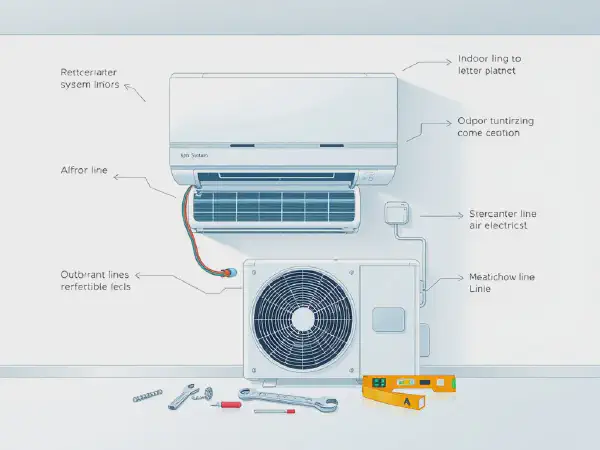Essential Guide to Split System Installation and Setup

A Comprehensive Guide to Split System Installation
Split System Installation is a crucial process for homeowners looking to enhance their indoor comfort. Split systems are an efficient way to heat or cool specific areas of a home, providing flexibility and energy savings compared to central air conditioning systems. Proper installation is key to maximizing system performance and longevity.
Efficient air conditioning melbourne installation can significantly enhance your home’s energy efficiency and provide a refreshing retreat during hot summers.
Before embarking on a Split System Installation, it's essential to understand the requirements and preparation needed. This includes selecting the proper unit size, identifying the best location for indoor and outdoor units, and familiarizing oneself with the installation procedure. Taking these preliminary steps will ensure a smoother installation process and better overall results.
For top-notch climate control solutions, consider our expert duct repair docklands services that ensure optimal airflow and comfort.
During the Split System Installation, attention to detail is vital. The installation involves several steps, including securing the indoor and outdoor units, establishing refrigerant lines, and connecting electrical components. Each step requires specific tools and techniques to ensure the system operates effectively and meets safety standards.
After the installation is complete, routine maintenance is essential to keep the system running efficiently. Knowing how to care for your split system will help prevent unexpected breakdowns and extend the unit's lifespan. Regular cleaning, timely repairs, and professional check-ups should be part of your maintenance routine.
In summary, Split System Installation requires careful planning, the right tools, and an understanding of the installation process. Comprehensive knowledge about the system and proper maintenance can significantly enhance your indoor comfort experience and ensure energy efficiency.
Planning for Split System Installation
Choosing the right location for installation is paramount. Indoor units should ideally be placed in a central area for even airflow, away from direct sunlight and heat sources to enhance efficiency. The outdoor unit requires sufficient space for airflow and maintenance, ideally positioned on a flat surface and away from obstructions.
Calculating the required cooling capacity is critical and depends on various factors, including room size, insulation quality, and local climate. A well-calibrated capacity ensures optimal temperature control without excessive energy consumption. It's recommended to consult a professional or use online calculators to determine the unit's BTU requirements accurately.
Understanding the installation process and timeframes helps homeowners set realistic expectations. The installation typically takes a few hours for a professional, while DIY installations may take longer depending on the skill level. Familiarizing yourself with the process can ensure a smoother flow and better preparation for any potential challenges.
Tools Required for Split System Installation
Essential tools for installation include drills, screwdrivers, wrenches, a level, refrigerant gauges, and tubing cutters. Each tool plays a significant role in each stage of the installation, from mounting the units to connecting refrigerant lines and wiring the electrical components.
Safety equipment and precautions are equally important. Always wear safety goggles, gloves, and a mask, especially when handling refrigerants and sharp tools. Ensuring safety during the installation process can prevent accidents and injuries, ensuring peace of mind.
Cost-effective tools for DIY installation can save money. Rent or borrow tools whenever possible, and consider purchasing secondhand equipment for occasional use. However, investing in high-quality essential tools can pay off in terms of efficiency and reliability during the installation process.
Step-by-Step Split System Installation
Preparing the area for installation involves clearing debris and ensuring unobstructed access for installation tools and equipment. This step also includes measuring the space to ensure correct positioning and ensuring that all necessary tools and materials are within reach.
Connecting the indoor and outdoor units is the most technical stage of Split System Installation. It requires careful adherence to the manufacturer's guidelines regarding refrigerant line connections and electrical wiring. Proper connections are vital for system efficiency, and any mistakes can lead to system failure.
Testing the system post-installation is crucial to ensure everything is functioning correctly. This step involves checking temperature settings, looking for leaks in refrigerant lines, and thoroughly inspecting both indoor and outdoor units. Conducting these tests will verify that the installation is successful and safe for regular use.
Common Issues in Split System Installation
Identifying installation mistakes is the first step in troubleshooting potential issues. Common errors include improperly sized units, incorrect refrigerant levels, or inadequate insulation of refrigerant lines, which can cause inefficiency or system failure. Understanding how to spot these mistakes can help address them before they become serious issues.
Troubleshooting poor performance requires recognizing symptoms like inconsistent temperatures, unusual noises, or increased electricity bills. Knowing how to identify these signs early can prevent further damage and help keep the system running efficiently.
To avoid future installation problems, always adhere to the manufacturer's guidelines, choose the right unit size, and ensure quality connections. Regular maintenance and check-ups by professionals can keep your system in good shape while catching any potential issues early on.
Maintenance Tips for Split Systems Post-Installation
Regular cleaning and upkeep of units is vital to maintaining system efficiency. Clean or replace filters every few weeks and remove debris from the outdoor unit to ensure unobstructed airflow, which is necessary for optimal performance.
Scheduling professional check-ups should be a part of your maintenance routine. Experts can spot issues that a homeowner might overlook and provide necessary adjustments or repairs to keep the system running smoothly. Regular maintenance appointments are vital to prolonging the life of the system.
Signs that indicate the need for maintenance include fluctuating temperatures, abnormal sounds, or increased energy bills. Being vigilant about these signs ensures that any problems are addressed quickly and effectively, preventing expensive future repairs.
